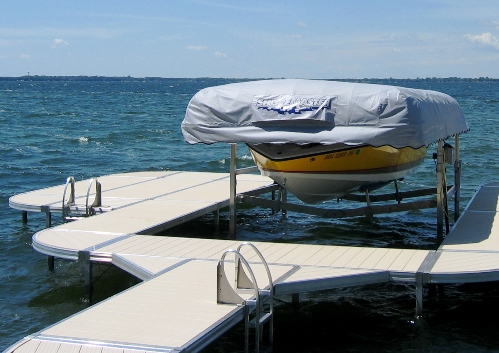
Jul 30, 2019
BOAT LIFT SELECTION
Purchasing a boat lift (new or used) can be very confusing. There is a lot to consider before making your selection. This article will assist you in making the right decision.
Let’s start with, where will you be using the boat lift?
Why is location important? The location will be an essential consideration for determining the suitability of a boat lift for the body of water you are on. Will you be on the Bay of Green Bay, Lake Winnebago, a river or a small inland lake?
On larger bodies of water, vertical boat lifts are the preferred choice. Why? The answer is the extra lifting height you get versus a cantilever lift.

2019 Storm Challenges
2019 is proving to be a challenging year for most dock and boat lift owners. With record-setting water depths and strong, frequent storms, owners see the need for the higher lifting capacities.
Unlike people on small lakes, the Bay of Green Bay and Lake Winnebago present unique problems for boaters. The reasons are the storm surges. A storm surge is caused by sustained winds blowing in one direction with no rivers or creeks on the leeward side to relieve the pressure of the water piling up. Wave action of 4 or more feet on top of a water surge makes the situation even worse.
These two factors combined, mean you will need a lift that raises high enough to keep your investment from being damaged. You also need the most durable frame construction possible.
Frame strength is achieved by using a more substantial square or rectangular frame versus a round, thin tube. If the frame is not strong enough, you won’t get the extra protection your boat deserves. That’s why PWS only handles ShoreMaster boat lifts.
Rivers have unique problems in the form of fluctuations in water depth in early spring from snow melting and heavy rain runoff during the season. Any boat lift must be capable of handling the changing water levels here too.
Depth of water is another consideration.
Vertical lifts, with a “V” rack, require about 6″ of water plus the draft of the boat to operate. This low water requirement is vital if the water recedes in late summer or fall.
Boat length, width, and weight affect your choice.
PWS recommends that you consider not only the length, width, and weight of the boat you currently have, but also the possibility of a larger boat in the future. It will save you money in the long run. People frequently change to a bigger, better boat, so you should not ignore this issue.
Why do we insist on checking the weight you give us for your boat?
It’s not that we don’t trust you – we simply don’t trust you, but in a good way. Our reputation is on the line with every lift we sell, so it has to be the right one for your needs. Some salespeople quickly choose the lift you “need” without even looking up the Specifications to be sure. Remember, the weight is more than the boat weight.
See also https://wisconsinpws.com/boat-lift-calculations-part-4/
Will you raise the boat by hand or do you need a motor?
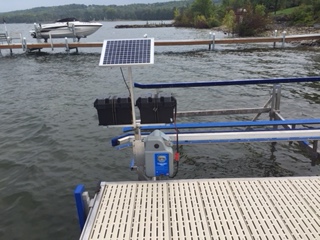
24 V Solar Panel arrangement
Do you want to raise your boat with the winch wheel or use a remote-controlled motor to do the work for you? 12V/24V D.C. motors power most boat lifts with 120V A.C. used less frequently.
Nature charges your battery via a solar panel, and there is no cost to do it.
A.C. versions, while available, require 120 V power at the boat site and require more care to prevent electrical shock.
What are the Frame Materials?
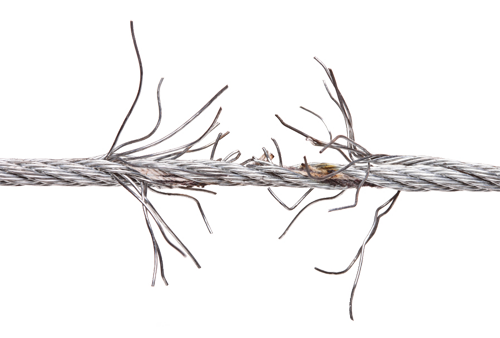
Corroded & Frayed Boatlift Cable
The most popular boat lifts in N.E. Wisconsin have aluminum frames and stainless steel cables.
There are still a few steel boat lifts around.
But they are few and far between due to their weight, limited lifting heights and susceptibility to rust.
Aluminum boat lifts will have either galvanized or stainless steel cables. Sometimes they have a combination of both materials. Stainless steel cables last as much as 2-4 times longer than galvanized steel cables and don’t rust.
What about the pulleys on the lift?
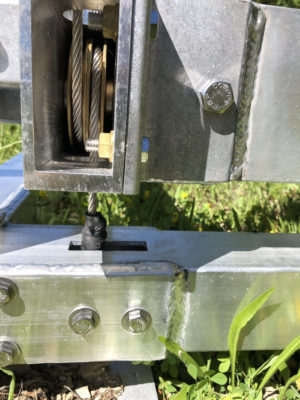
ShoreMaster Brass Pulleys
Pulleys on boat lifts will be either plastic, steel or brass construction. Robust brass pulleys with stainless steel hubs are
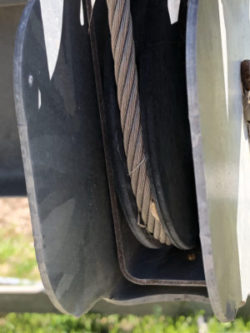
Plastic Pulleys
the best choice while plastic pulleys are not recommended even on the lighter PWC lifts. The heavier the boat, the more critical it is to have stainless steel and brass materials.
Plastic pulleys become brittle over time. Eventually, the edges break off, and the cable gets jammed between the frame and the pulley. Raising a boat with a jammed cable is extremely hard to do.
Who will install the boat lift?
A professional company is best suited to do this for you.
Boat lifts in the 5000# range or larger, definitely require professional installation and removal services. It’s not a job for amateurs. Do you have a dependable provider for this service? PWS has experienced, trained people and the necessary equipment to do it for you,
What is the Warranty?
Many boat lifts come with a 1 or 2-year factory structural warranty. Some have five-year, and a few even have a 10-year warranty. ShoreMaster boat lifts carry a full 15-year structural warranty. The 15-year warranty is the best on the market.
SEE https://shoremasteravala.blob.core.windows.net/media/1588/shoremaster-warranty-12142016.pdf
Now it’s up to you! Our recommendation? See what your neighbors have to say about PWS.

Customer Testimonials
Do you have a friend that might be interested in this post? Please forward it to them.
Pier & Waterfront Solutions
PWS is located at 7325 St. Hwy 57. That’s 1 mile North of County MM (Hwy 42) and 3 miles south of Sturgeon Bay at the Idlewild Road intersection. Or – for more information, you can call Jerry @ 920-493-4404.
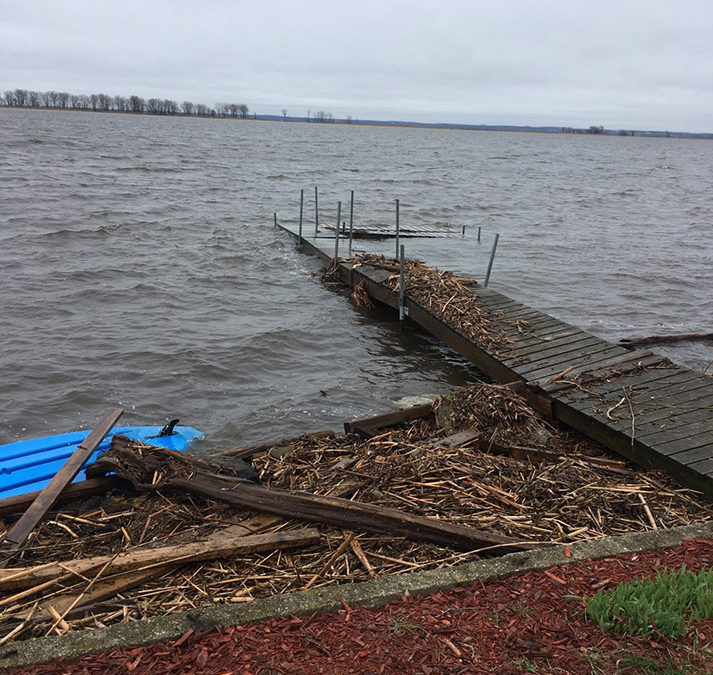
May 7, 2019
STORM DAMAGE
Storm damage on May 1 has caused dock owners to ask – Will my dock and lift be installed by Memorial Day? The second question is – Why do you set the dock so high? The answer to the first question is – It’s still too early to tell.
In an average season, installations will begin about April 1. Last year, there were several minor snow days in April. Three weeks into the season we experienced a late-season snowstorm of 23.2”. Obviously, this slowed us down even more. Once the snow stopped, it took a few days for it to melt and the properties to dry out enough that we could access them again.
2019 Installs
The 2019 install season started as usual. Since then everyone has been hampered by
-
-
- High winds (mostly from the N and NE);
- Frequent rain has resulted in wet lawns and fields which mean – inaccessible properties; and
- High water levels again this year. (Yes, the water levels are even higher than in 2018.)
Also, keep in mind that in April, the water temperatures are barely above freezing and wet suits and waders provide little, if any, protection.
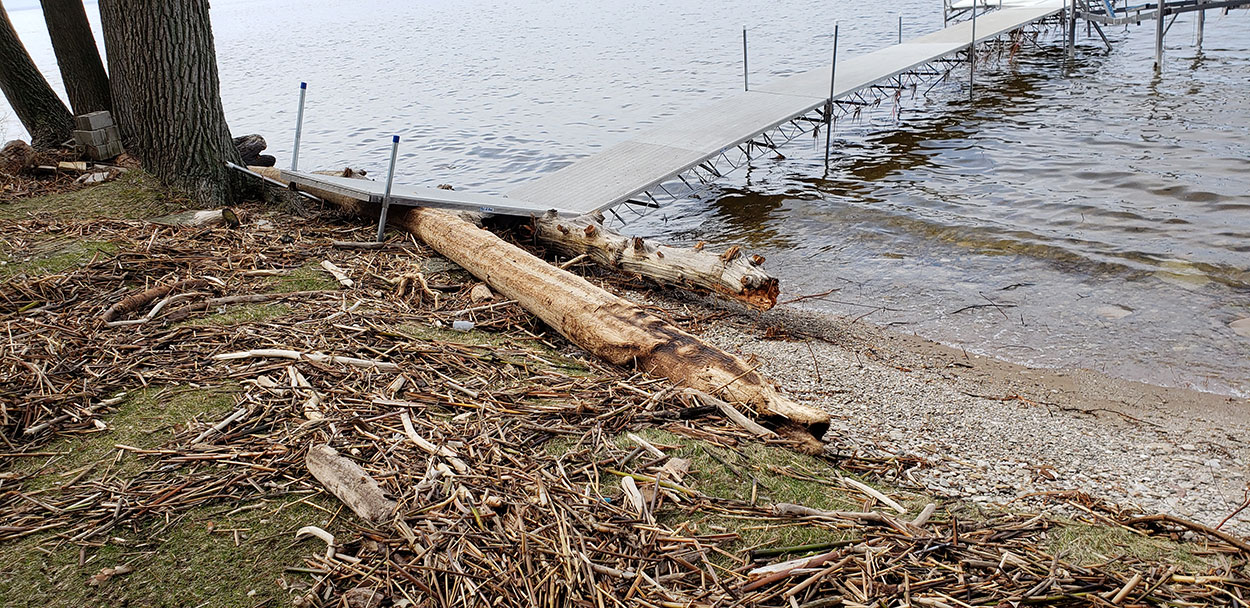
Storm Damage caused by floating logs
Let’s address each issue
Here’s an example of the storm damage that occurred on the morning of May 1, this year.
Around sunset on the evening of April 30th, the winds switched from the E to the NE. The winds kept building until 2 am. That’s when there was a sharp increase in wind gusts approaching 40 mph from the NE. These strong gusts lasted until 5 am and then tapered off, but only slightly. Combine this with steady winds – 20-30 MPH (all from the NE), and you have a recipe for storm damage. The result was a storm “surge” approaching 3 feet in water depth – with strong wave action on top of that.
The rising waters peaked about 10 am. This “surge,” combined with the wind gusts, resulted in damage to the docks that had already been installed. Some docks were completely submerged despite being set high above the current water depth. The result was we had to go back to assist those people with damage.

Storm Damage – May 2019
Here is the information provided by the National Weather Service.
National Weather Service data for May 1
WIND (MPH)
HIGHEST WIND SPEED 30 HIGHEST WIND DIRECTION NE (40)
HIGHEST GUST SPEED 39 HIGHEST GUST DIRECTION NE (40)
AVERAGE WIND SPEED 14.5
WHAT CAUSES A STORM SURGE?
For a better explanation of why the water levels rise so high in Door County – see our previous post entitled – What is a water surge?
It’s also a good idea to refer to another post entitled – Boat Lift insurance which was published the morning before the storm. See the section on “wave damage.” By the way, we DO NOT have a direct line set up with Nature to anticipate these occurrences.
We are currently receiving actual photos to publish in this same article. Check back in a few days. Feel free to send any photos you may have. We may use them as well. Send them to mike@wisconsinpws.com.
STANDING WATER
Heavy snow this winter and frequent rains throughout Spring means most lawns and access areas have standing water. We can not move our equipment over it until it drys or we risk heavy damage to your yard.
FAQ – WHY MUST MY DOCK BE SET SO HIGH?
The water levels have been rising for a couple of years. This forces us to extend the legs to accommodate the higher water. By doing that we help protect you from storm damage.
As mentioned in a previous post you may receive a call from John, our service manager, seeking your permission to add longer legs to accommodate the increased water depths. The only alternative is not to install all the sections of the dock – usually one less section. Putting in one less section may be a temporary “fix” to help this year, but it is not a guarantee.
John NEVER calls unless it is necessary because we know it costs more to add new legs and it slows our install schedule down. The biggest cost is the labor to remove and replace the existing legs.
If you have augers on the legs, your dock must be placed on its side to remove and replace the legs. Last year some legs were already very short due to the higher lake levels. With even more depth this year we anticipated this leg replacement to be more frequent. All of our trucks go out with extra material each morning in anticipation of needing to replace dock legs.
If you get a call from John that usually means the crews are at your site and need your response. Without it they must move on to another location. Please return John’s call ASAP to keep things moving.
Check back here each week for any updates on the installs. We’ll share as much information as we can.
PWS is located at 7325 St. Hwy 57. That’s 1 mile North of County MM (Hwy 42) and 3 miles South of Sturgeon Bay at the Idlewild Road intersection.
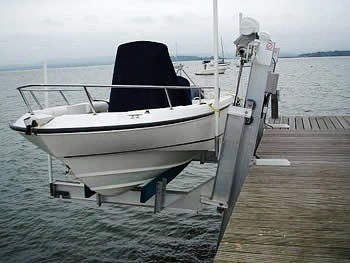
Feb 12, 2019
WHAT STYLES OF BOAT LIFTS ARE AVAILABLE?
What boat lifts are available for your use? Part 1 of this series discussed the least common types of boat lifts used in Wisconsin waters. Now let’s look at more common types of boat lifts available for your selection.
Hydraulic Boat Lifts
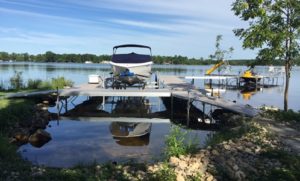
Hydraulic Lift by ShoreMaster
Hydraulic boat lifts generally lift the highest of the available lifts. (up to 6’ high on some models). The lifting height along with the wide stance of the base gives you excellent protection for your boat. It is recommended for high waves and water surges during storms.
Hydraulic boat lifts are D.C. operated units which are quiet and use solar-powered batteries and remote controls.
ELEVATOR LIFTS
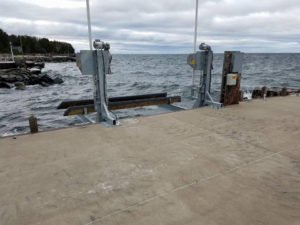
12,000# Davit Master Elevator Lift
Elevator Lifts are used with permanent pier installations (usually concrete piers or piling piers.) The elevator lifts raise the boat sideways as shown to the right and below. They lift the boat above the pier height. They are common in channels and lakes with large fluctuations in water depth and no ice movement in winter.
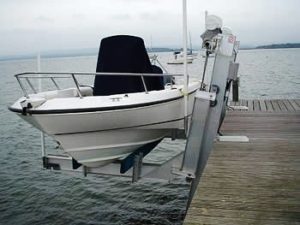 12,000# DavitMaster Elevator Lift
12,000# DavitMaster Elevator Lift
Davit Master Elevator Boat Lifts feature:
- All welded design for strength and durability;
- 6061-T6 Marine Grade Aluminum or Hot-dipped galvanized steel construction;
- Heavy duty adjustable PVC pipe guides with insert reinforcement;
- Adjustable chock system;
- Stainless steel motors for added protection;
- Stainless steel cables with aluminum grooved cable winders
- Aluminum sheaves plus Stainless steel bolts with grease fittings; and
- A Comprehensive warranty.
Some models even allow pivot construction for winter storage.
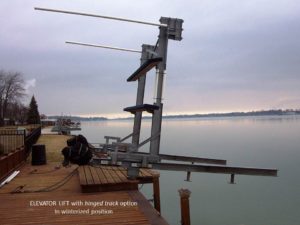
Floating Rhino Lifts
HANDCRAFTED FOR TOUGH WATERFRONT ENVIRONMENTS
Rhino Lifts were originally built to withstand the brutal marine environment of Lake of the Ozarks, Missouri where very deep water is common. This type of lift is now the preferred choice for boat owners who want the ultimate in strength, durability, and boat lift performance.
Each lift – expertly welded, and hot-dip galvanized also has the highest level of convenience and safety for the people who use it.
The Rhino Lift Floating Boat Lift allows you to raise and lower your lift with the push of a button. You have the peace-of-mind gained from trusting the same equipment used by marinas, restaurants, and resorts across the United States and Canada.
The L-Arm Floating Boat Lift mounts between a U-shaped dock.
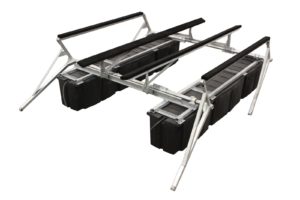
Rhino Lift L-Arm Floating Lift
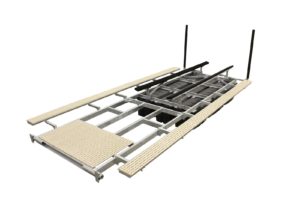
Rhino Lift Front Mount Floating Lift
Front Mount Rhino Boat Lifts require a dock at the front of the lift only. It has a walking platform on three sides for loading and unloading. The lift is only secured at the front of the lift.
These floating lifts cannot be exposed to high waves. As a result, they generally go into marinas or deep water environments.
After reading Part 1 and 2 of this series, you have a better idea about the types of boat lifts generally used in Wisconsin. In Part 3 we will talk about the most popular boat lift used in Door County.
Publication Dates
Part 1 of 4 – Cantilever, PWC, ShorePorts, Tracks Feb 5, 2019
2 of 4 – Hydraulic, Elevator Lifts, Floating lifts Feb 12, 2019
3 of 4 – Vertical lifts Feb 19, 2019
4 of 4 – Calculations Feb 26. 2019
Do you have a friend that may be interested in this information? Why not share a link to this article with them?
PWS is located at 7325 State Hwy 57, that’s 1 mile North of County MM (Hwy 42) and 3 miles South of Sturgeon Bay at the Idlewild Road intersection. Our staff is here year-round to assist you.

Feb 5, 2019
WHAT SIZE BOAT LIFT DO I NEED?
A boatlift can come in several styles. In this first of a four-part series, we discuss Cantilever, PWC, ShorePorts, and Track systems.
Each boatlift has a specific way it operates, and the conditions under which it should be used. We’ve narrowed the selections down to (8) different types of boat lifts and PWC lifts used most often in N.E. Wisconsin. The more you know about them the more confident your purchasing decision will be.
Cantilever Boatlift
A cantilever lift is generally suitable if you are on a moderate depth inland lake. If the water depth does not fluctuate more than 12” in a boating season, a cantilever lift may work for you.

Cantilever Boatlift by ShoreMaster
Cantilever boatlifts require more water depth than a Vertical lift – (usually 12” of water versus 6″). The lifting rack does not lower into the water as far as other options. Plus, you still have to allow enough water above the lift rack to float your boat on it.
Additionally, they generally have a lifting height of 30” to 40” which is too low for the bay of Green Bay. What if you have waves of 36” or higher or a water surge. Your boat is in danger of getting washed off the rack.
Due to these limitations, a cantilever boat lift is not used on the Door County Peninsula very often. These limitations also mean the resale value is going to be less.
PWC Lift
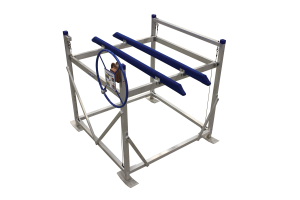
Vertical PWC Lift by ShoreMaster
PWC (Jet Ski lifts) come in 2 styles: Vertical and Floating. (We have excluded the Cantilever lifts.)
ShoreMaster’s vertical PWC lifts allow you to get into shallow water and raises your boat 50″ high. It operates in the same fashion as a standard vertical boat lift. It provides excellent protection for your PWC.
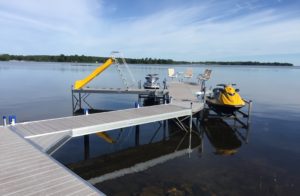
ShoreMaster PWC Lift
ShorePort
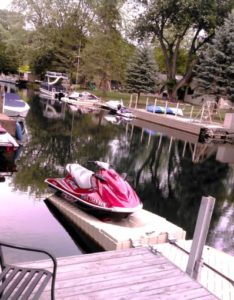
ShorePort PWC Lift by ShoreMaster
ShoreMaster’s Floating lifts (ShorePort) are excellent on rivers that fluctuate in depth, or marinas and inland lakes. They are very simple to use and need very little water to operate. The floating lift requires no maintenance, and you simply drive up onto it. No need to have a motor or crank a wheel.
Wave action above 15” is not recommended for this type of “boatlift.” Combine a floating PolyDock with the PWC floating lift, for the perfect combination on a lake or river.
Track or Ramp System
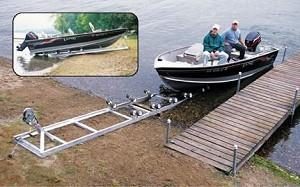
Roll-n-Go Boat Ramp
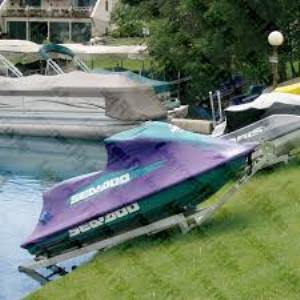
Roll-n-Go PWC Track System
The track or ramp system is still another option. The personal watercraft ramp comes with a 25-foot nylon loop and winch which prevents scratching while loading the PWC. The basic unit measures 11′ long. There are optional 8′ and 30″ extensions to increase the length of your ramp. How about an adjustable 11″ – 14″ width which accommodates even the largest jet skis.
Basic ramps are available with capacities of 750 lb up to 2,000 lb capacity. See Also: http://roll-n-go.com/
The Track system works best when the supports can be anchored into the ground. Without anchoring, the tracks can move by wave action and the result is a twisted frame. These are ideal for inland lakes when only the basic length is needed, as shown above, and the track is secured.
The PWC or boat can be hand operated or a Lift Boss motor option is available.
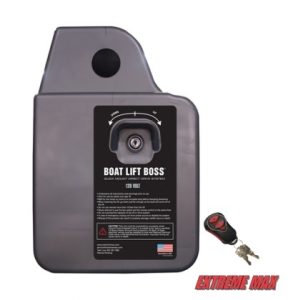
Lift Boss
In part 2 of this series we discuss three more options: Hydraulic boatlifts, Elevator lifts, and Floating lifts.
Publication Dates
Part 1 of 4 – Cantilever, PWC, ShorePorts, Tracks Feb 5, 2019
2 of 4 – Hydraulic, Elevator Lifts, Floating lifts Feb 12, 2019
3 of 4 – Vertical lifts Feb 19, 2019
4 of 4 – Calculations Feb 26. 2019
Do you have a friend that may be interested in this information? Please share a link to this article with them.
PWS is located at 7325 State Hwy 57, that’s 1 mile North of County MM (Hwy 42) and 3 miles South of Sturgeon Bay at the Idlewild Road intersection. Our staff is here year-round to assist you.
Jun 5, 2018
How to Select BoatLifts – Part 2
Boatlifts come in several configurations. In part 1 of this 2 part series, we discussed vertical and cantilever lifts. What about boatlifts for larger boats?
Next, we’ll discuss Elevator and Hydraulic boatlifts.
Elevator Lift
The elevator boatlift can only be mounted on permanent piers. These piers usually consist of a concrete pier (or concrete capped, boulder pier) or as an alternate a pier mounted on permanent pilings. As shown below, the elevator lift raises the boat parallel to the pier for easy access to the boat. They are commonly used in channels and lakes with significant fluctuations in water depth.
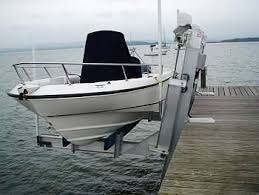
Elevator BoatLifts
The elevator lift is powered by one or two synchronized A.C. electric motors depending on the unit size. There is no need to hand-crank this lift. A wireless remote control is used to raise or lower the boat.
Elevator boatlifts are capable of stopping anywhere along its vertical travel so it makes it simple to load and unload a boat. This boatlift makes the boat readily accessible for covering with a boat cover and loading.
Hydraulic BoatLift
In general, Hydraulic boatlifts will travel 4’, 5′ or 6’ vertically depending on the model ordered. They will handle loads up to 32,000 lbs.
Because the base is wider than a typical cantilever or vertical boat lift, you have more stability in storms.
The Hydraulic lift is one of the best for high waves and water surges. The D.C. operated units are quiet and use solar-powered batteries and wireless remote controls. No A.C. power required.
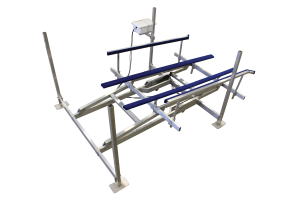
Hydraulic BoatLifts by ShoreMaster
Where can you find the solution to any boatlift situation?
At Pier & Waterfront Solutions, of course!
PWS is located 1 mile North of County MM (Hwy 42) at 7325 St. Hwy 42/57. That’s just 3 miles South of Sturgeon Bay. Look for the Idlewild Road intersection.
Our staff is ready to assist year round.
Call if you want to see an issue discussed on our site.
Contact Jerry at 920-493-4404 or Email Jerry@wisconsinpws.com with your questions.































